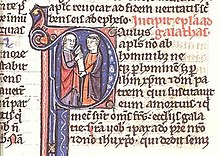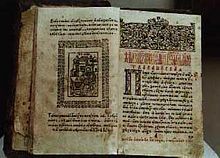Epistle
An epistle (
Ancient Egyptian epistles
The
Ancient Greece and Rome
This section needs expansion. You can help by adding to it. (January 2010) |
Epistles in prose and verse were a major genre of literature among the
Form of Christian epistles
Christian epistles, both those in the New Testament and among the early Christian Fathers, were written in accordance with the formalized,
Opening/greetings
In contrast to modern letters, epistles usually named the author at the very beginning, followed by the recipient (for example, see
After the names of the author and recipient, Pauline epistles often open with the greeting, "Grace and peace to you." "Grace" was a common Hellenistic greeting, while "peace" (shalom) was the common Jewish greeting; this reflected Paul's dual identity in Jewish faith and Hellenistic culture. There may also be a word of thanks to the audience. In secular letters, a prayer or wish for health followed.
Content/body
The body begins with a brief statement introducing the main topic of the entire body.
New Testament epistles
The epistles of the New Testament canon are usually divided as follows:
Pauline epistles
The Pauline epistles, also called Epistles of Paul or Letters of Paul, are the thirteen books of the
The Pauline epistles are usually placed between the Acts of the Apostles and the Catholic epistles in modern editions. Most Greek manuscripts, however, place the General epistles first,[6] and a few minuscules (175, 325, 336, and 1424) place the Pauline epistles at the end of the New Testament.
| Status | Categorisation[7] | Epistle |
|---|---|---|
| Undisputed | Authentic Pauline epistles | |
| Disputed | Deutero-Pauline epistles; may be authentic |
|
| Pastoral epistles; probably not authentic |
||
| Anonymous sermon; not Pauline |
Catholic (i.e., "general") epistles
The catholic epistles (also called the general epistles[8]) are seven epistles of the New Testament. Listed in order of their appearance in the New Testament, the catholic epistles are:
| Traditional epistle name | Author according to the text (NRSV) | Traditional attribution[9] | Modern consensus[9] | Addressee(s) according to the text (NRSV) |
|---|---|---|---|---|
| Epistle of James | "James, a servant of God and of the Lord Jesus Christ" | James, brother of Jesus | An unknown James | "To the twelve tribes in the Dispersion"[10] |
| First Epistle of Peter | "Peter, an apostle of Jesus Christ" | Simon Peter | Maybe Simon Peter | "To the exiles of the Dispersion in Pontus, Galatia, Cappadocia, Asia and Bithynia"[11] |
| Second Epistle of Peter | "Sim(e)on Peter, a servant and apostle of Jesus Christ" | Simon Peter | Not Simon Peter | To all Christians[12] |
| First Epistle of John | anonymous | John, son of Zebedee | Unknown | To fellow Christians[13] |
| Second Epistle of John | anonymous | John, son of Zebedee | Unknown | "To the elect lady and her children"[14] |
| Third Epistle of John | anonymous | John, son of Zebedee | Unknown | "To the beloved Gaius"[15] |
| Epistle of Jude | "Jude" (or "Judas"), "a servant," (Gk. slave), "of Jesus Christ and brother of James" | Jude, brother of Jesus | An unknown Jude | To all Christians[16] |
Non canonical epistles
- Correspondence of Paul and Seneca, a set of 14 letters also known as the Epistle to Seneca the Younger
- Third Epistle to the Corinthians (canonical for a time in the Armenian Orthodox), also a correspondence of two letters
- Epistle to the Laodiceans (Latin version found in Codex Fuldensis)
- Letter of Peter to Philip
Lost epistles
- The first Epistle to Corinth[17] referenced at 1 Corinthians 5:9
- The third Epistle to Corinth called Severe Letter referenced at 2 Corinthians 2:4 and 2 Corinthians 7:8–9
- The Corinthian letter to Paul referenced at 1 Corinthians 7:1
- The Earlier Epistle to the Ephesians referenced at Ephesians 3:3–4
- The Epistle to the Laodiceans referenced at Colossians 4:16
- The Earlier Epistle of Jude[18] referenced at Jude 1:3
- The Earlier Epistle of John[19] referenced at 3 John 1:9
Epistles of Apostolic Fathers
These are letters written by some very early Christian leaders, in the 1st or 2nd century, which are not part of the New Testament. They are generally considered to form part of the basis of Christian tradition. The ennobling word "epistle" is used partly because these were all written in Greek, in a time period close to when the epistles of the New Testament were written, and thus "epistle" lends additional weight of authority.
- Epistle of the Romans to the Corinthians (1 Clement)
- Epistle of Ignatius to the Ephesians
- Epistle of Ignatius to the Magnesians
- Epistle of Ignatius to the Trallians
- Epistle of Ignatius to the Romans
- Epistle of Ignatius to the Philadelphians
- Epistle of Ignatius to the Smyrnaeans
- Epistle of Ignatius to Polycarp
- Epistle of Polycarp to the Philippians
- Epistle of Barnabas
- Epistle to Diognetus
Liturgical use

In the context of a
Western churches
In the Roman Catholic Mass and Anglican Eucharist, epistles are read between the Collect and the Gospel reading. The corresponding Gregorian chants have a special tone (tonus epistolae). When the epistle is sung or chanted at Solemn Mass it is done so by the subdeacon. Epistles are also read by an Elder or Bishop in the Lutheran Divine Service, between the gradual and the Gospel.
Eastern churches

In the
Medieval epistles
During the Middle Ages, the art of letter writing was taught in numerous manuals, and the ars dictaminis became an important genre of instructional discourse. The necessity for letter writing was in large part due to the general deterioration of civil life and the decay of the Roman road system in the early Middle Ages, factors that obliged literate people with business to transact to send letters instead of travel themselves.[21] A vast number of letters and letter-writing manuals were written in the period's lingua franca, Latin.[22]
See also
- Acts of the Apostles (genre)
- Agrapha
- Authorship of the Bible
- Epistle (Quaker)
- Epistolography
- Epistolary novel, a novel written as a series of letters or similar writings
- Epistolary poem
- Letter collection
- New Testament apocrypha
- Pseudepigraphy
- Textual criticism
- Shikshapatri
Notes
- ^ ISBN 978-1555404734.
- ^ Reece, Steve. Paul's Large Letters: Pauline Subscriptions in the Light of Ancient Epistolary Conventions. London: T&T Clark, 2016. Paul's Large Letters
- ^ The New Jerome Biblical Commentary, publ. Geoffrey Chapman, 1989, chapter 60, at p. 920, col. 2 "That Paul is neither directly nor indirectly the author is now the view of scholars almost without exception. For details, see Kümmel, I[ntroduction to the] N[ew] T[estament, Nashville, 1975] 392–94, 401–03"
- ^ a b New Testament Letter Structure, from Catholic Resources by Felix Just, S.J.
- ^ Richards, E. Randolph. Paul and First-Century Letter Writing: Secretaries, Composition and Collection. Downers Grove, IL; Leicester, England: InterVarsity Press; Apollos, 2004. [page needed]
- ISBN 0198261802. Archived from the original(PDF) on 2013-06-01.
- ^ Ehrman, Bart (16 December 2014). "Pauline Forgeries: 2 Thessalonians as a Test Case". The Bart Ehrman Blog. Bart Ehrman Foundation. Retrieved 21 February 2022.
Scholars normally place the thirteen Pauline letters of the New Testament into three categories: The Pastoral Epistles of 1 and 2 Timothy and Titus, which are very widely recognized as having been written by someone other than Paul; the Deutero-Pauline letters of Ephesians, Colossians, and 2 Thessalonians, which are fairly widely as being written by other authors (three different authors; these must be judged as authentic or not on a case by case basis); and the other seven letters, which are called the 'Undisputed Paulines': Romans, 1 and 2 Corinthians, Galatians, Philippians, 1 Thessalonians, and Philemon.
- ^ Encarta-encyclopedie Winkler Prins (1993–2002) s.v. "katholieke brieven". Microsoft Corporation/Het Spectrum.
- ^ ISBN 978-0195141832.
- ^ James 1:1
- ^ 1 Peter 1:1
- ^ 2 Peter 1:1, "To those who have received a faith as precious as ours through the righteousness of our God and Savior Jesus Christ"
- ^ The letter addresses the audience as "my dear children" (e.g. 1 John 2:1) and "dear friends" (e.g. 1 John 2:7). 1 John 3:2 states: 'Dear friends, now we are children of God...', showing that the author is addressing fellow Christians, whom he intermittently calls 'children of God' (which includes himself), as well as 'dear friends' (or 'beloved' in some translations).
- ^ 2 John 2
- ^ 3 John 1
- ^ Jude 1, "To those who are called, who are beloved in God the Father and kept safe for Jesus Christ"
- ^ Also called "A Prior Epistle of Paul to the Corinthians""Lost Books of the Bible?". Archived from the original on 2006-06-23. Retrieved 2006-06-29. or "Paul’s previous Corinthian letter".[1], possibly Third Epistle to the Corinthians
- ^ Also called 2 Jude.
- ^ Also called "The Epistle of John to the Church Ruled by Diotrephes" Archived 2006-06-23 at the Wayback Machine
- ^ Herbermann, Charles, ed. (1913). . Catholic Encyclopedia. New York: Robert Appleton Company.
- ISBN 978-1570036514.
- ISBN 978-1570036514.
External links
- Gosse, Edmund William (1911). . Encyclopædia Britannica. Vol. 9 (11th ed.). pp. 701–703.
- Catholic Encyclopedia: Epistles
- David Trobisch, "How to read an ancient letter collection", 1999: the possibility of a narrative critical study of the Letters of Paul
